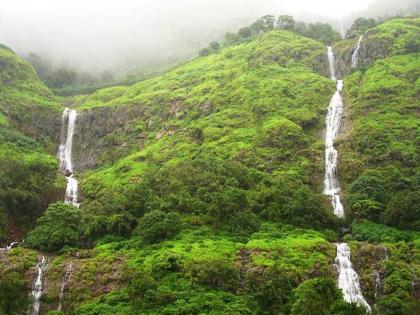Pune: Tourism Temporary Ban in Bhimashankar and Tamhini Sanctuaries During Monsoon Till September 30
By Lokmat English Desk | Updated: July 2, 2024 08:40 IST2024-07-02T08:39:47+5:302024-07-02T08:40:25+5:30
In response to increased accidents in Pune district's challenging landscapes, the district administration and forest department have announced a ...

Pune: Tourism Temporary Ban in Bhimashankar and Tamhini Sanctuaries During Monsoon Till September 30
In response to increased accidents in Pune district's challenging landscapes, the district administration and forest department have announced a temporary ban on entry to Bhimashankar and Tamhini sanctuaries during peak monsoon, effective until September 30, 2024.
During the monsoon season, residents of Pune often visit scenic tourist destinations in nearby Tehsils such as Mulshi and Maval to immerse themselves in nature. While these locations are known for their beauty, accessing them during the rainy season can be hazardous and challenging.
Among these spots, certain waterfalls and areas within the Tamhini Wildlife Sanctuary and Bhimashankar Wildlife Sanctuary are particularly popular among tourists. Recently, the Maharashtra Forest Department issued a crucial update regarding these locations, imposing a temporary ban on entry until the conclusion of the monsoon season.
Also Read| Pune's Tamhini Ghat Waterfall Tragedy: Young Man Goes Missing After Jumping, Video Goes Viral.
In Bhimashankar, the Maharashtra Forest Department has identified six waterfalls and has closed all connecting routes and trails to visitors. These include Kondhwal Waterfall, Chondi-Khopiwali Waterfall, Nhani Waterfall near Padarwadi, Subhedar Waterfall near Nariwali, Ghongal Ghat Nala-Khandas-Bhimashankar route, and Shidi ghat-Padarwadi-Kathewadi route.
Tushar Chavan, deputy conservator of forest (wildlife), Pune forest department, said, ”Tamhini, Bhimashankar Wildlife Sanctuaries and some other areas in Maval, Mulshi, and Junnar tehsils are known for its scenic beauty and waterfalls. Many tourists are attracted to these places during the monsoon. However, the unpredictable water flow and slippery paths pose significant risks.”
Open in app